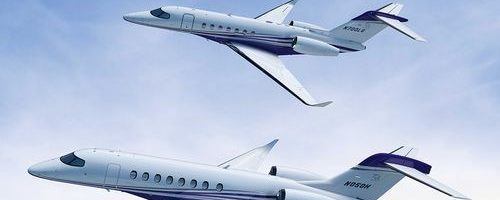Smaller Engines Fuel Future Growth

Cessna is plotting an industry transformation with its large-cabin, long-range business jet. With smaller engines that promote increased fuel-efficiency and decreased pollution, the Citation Hemisphere will appeal to business travelers that increasingly demand environmental improvements.

The Cessna Citation was one of the first business jets to become a household name across America. But by the 1990s, the Citation was losing market share, credibility, and notoriety to its competition that was willing to innovate key features, market to a wider audience, and deliver results. Rappers, athletes, and celebrities preferred the brand recognition of a Gulfstream V (pronounced “G-5”) to the heritage and reliability of a Cessna Citation.
In 2009 in the wake of the financial recession, Cessna announced its plans to exit the large-cabin, long-range market. Due to cost overruns, delayed timelines, and decreased demand, the Citation Columbus needed a complete makeover. It would take another six years before that transformation was ready to be publicly discussed.
In 2015, Scott Ernest (disappointingly, no relation to Justin Ernest of Section C Skydeck) made a newsworthy announcement at the National Business Aviation Association annual meeting in Las Vegas. As the President of Textron Aviation (parent company of Cessna), he boldly asserted that the Citation Hemisphere would revolutionize the large-cabin, long-range business jet market with technological improvements, improved operating efficiencies, lower purchase price, and a lower operating cost than any competitor.
The large-cabin, long-range market was unique in the world of business aviation. Among all categories of general aviation, this segment was the most resilient to economic downturns. A long-range entrant would diversify Textron Aviation’s business; with no options in the large-cabin category, loyal Textron customers were forced to support other competitors. Lastly, more customers wanted longer ranges and increased cabin sizes that allowed nonstop intercontinental travel from Chicago to St. Petersburg, Sydney to Shanghai, or Rio de Janeiro to Nairobi. Entry into the large-cabin, long-range market was the next logical step for an aviation behemoth like Cessna.[1]
The big surprise, however, came when Ernest announced which engines would be powering the new aircraft. Instead of using a Honeywell HTF7700L (as had been used on the Hemisphere’s sister program, the Longitude) or the Pratt & Whitney Canada PW800 (as had been designed for the Columbus), the Hemisphere would be powered by two Snecma Silvercrest 2C engines. These smaller engines produced roughly 25% less thrust than the PW800, decreased maximum cruise velocities to Mach .9, and lengthened runway requirements. Despite all these supposed problems, the announcement sent shock waves across the aerospace supplier markets for another reason.[2]
Snecma, recently renamed Safran Aircraft Systems, had a long history in aerospace. Snecma was one of the first partners to produce engines for the supersonic Concorde, and the firm continued to experiment and design components for commercial and military applications. But in the world of general aviation, Snecma was a new entrant to the already packed field.
The Snecma Silvercrest had never been used on a production airframe. In fact, the only other platform that planned to use the engine, the Dassault Falcon 5, had been delayed almost three years due to supply chain problems with the Silvercrest engines. Textron’s choice of selecting the unknown player when the competitors were so well-established seemed to many industry analysts as a peculiar choice.[3]
With its two engines each producing 12,000 pounds of thrust, the Snecma Silvercrest engines were a huge gamble for Ernest and the future of the Citation Hemisphere.
The Silvercrest engines incorporate the latest advanced, field-proven technologies to offer unrivaled performance in its class in terms of direct operating cost, propulsion efficiency, reliability, and environmental friendliness. These engines lower fuel consumption by up to 15%, reduce NOx emissions by up to 40% under CAEP/6 standards and half the noise footprint compared to other engines in its class.[4]
For an industry used to talking about speed, distance, and size, this statement signaled a change by Textron. Ernest and his team would design an airframe that was more fuel-efficient, more focused on pollutant reduction, and quieter than any other market player. Minimizing its CO2, NOx, and noise footprints was not just good publicity, it was good business. With air travel a major contributor to carbon emissions (the primary culprit for global climate change), Textron was banking on the fact that travelers would demand more environmentally friendly options in the future.
With the unveiling of the Citation Hemisphere still two years away, it is unclear what other bold moves the design team will be making. Wingtip devices (used to increase lift and decrease drag) are a standard feature on all long-range business jets, and a shift from aluminum components to carbon fiber will help reduce weight. But central to the success of this program will be the increased fuel efficiency of the Snecma Silvercrest engines.
Put yourself in the shoes of Scott Ernest:
- What are the advantages of the Silvercrest engine? What are the disadvantages?
- How would you market the new airplane? Be specific with your marketing plan.
(791 words)
[1] Davies, Alud. (2015, November 16). Cessna Launches Citation Hemisphere. www.corporatejetinvestor.com/articles/cessna-launches-citation-hemisphere-765/
[2] Siebenmark, Jerry. “Citation Hemisphere’s Engine Maker in Big Acquisition.” Wichita Eagle. 2017 January 19.
[3] Schonland, Allison. (2016, October 31). “Cessna Bets on the Silvercrest.” https://www.airinsight.com/cessna-bets-silvercrest/
[4] Textron Sales Brochure. http://cessna.txtav.com/en/citation/hemisphere#_model-powerplant.



A really interesting article, highlighting a bold gamble on the part of Cessna which I hope succeeds. In response to your first question, concern would be that the value proposition of a business jet for corporate customers is very different to that of a commercial airliner for individual travellers.
Whereas I do think individual passengers would be willing to pay for a flight on a slightly slower plane if they thought it was cheaper and better for the environment, I’m not sure the same incentives would operate for high-flying (no pun intended) business executives.
Specifically, once a company has crossed the threshold of flying it’s C-suite round in private jets, is it really much easier from a PR perspective for that company to explain to the public that it’s jets are 15% more fuel efficient and 40% better for the environment than other companies? Perhaps. But given how precious most senior executives time is, in the absence of a public scandal I think they will take some persuading that the marginal mitigation of reputational risk is worth arriving later than their competitors for the same meetings.
Chip, this is a great article about an interesting topic. I think that this innovation is a prime example of technology that can deliver higher customer satisfaction while reducing environmental impact, similar to the latest hypercars that use hybrid powertrains to increase performance while reducing CO2 emissions. While the new turbines clearly deliver less power and velocity, I believe that the fuel efficiency gains can be enormously attractive to private jetsetters, since the fuel costs for private jets can run into the thousands of dollars per hour. So, to address your question of how I would market the plane, I would use the fuel improvements to bring back the theme of democratizing private jets by making them more friendly for pilots (I understand that Citations are easier to fly than Lear jets, for example) and for wallets.
Additionally, I would be interested to learn if these technologies are already being used by larger commercial airliners, since according to the Air Transport Action Group, they produce 12% of global emissions from all transport sources (atag.org).
Chip, I think that this piece encapsulates the question of “what are we willing to sacrifice for the good of our environment?” The most interesting part of this paper is that this question is not being asked of the layperson, but of the Fortune 500 company looking to buy their new private jets. Cessna is taking a gamble here, hoping that executives and companies will see the benefits of lower fuel consumption and reduced emissions without feeling like they are sacrificing much in regards to thrust, speed, and airport restrictions.
I see the Citation Hemisphere as a huge potential for the industry of private planes, depending on price. With the G-650 pricetag currently hovering around $70 million and the Citation Hemisphere expected to launch at closer to $35 million, the Citation seems like a no-brainer.[1,2] A smaller carbon footprint is something nearly every company loves to brag about, regardless of how they achieve it, and they can even do it at a discount!
My only concern is the size of the market that this will impact. As a layperson, what can I do when traveling to reduce my carbon footprint? Will Airbus and Boeing introduce similar measures and begin to fight not just on speed or capacity, but on emissions? It looks like most of these businesses already meet Paris Accord requirements, but perhaps that means our standards aren’t set high enough.[3]
1. https://www.flyingmag.com/aircraft/jets/textron-aviation-launches-citation-hemisphere
2. http://www.businessinsider.com/photos-tour-the-65-million-gulfstream-g650-2013-7
3. https://www.nytimes.com/2016/02/16/business/energy-environment/a-hollow-agreement-on-aviation-emissions.html
Great read. I think this is a particularly interesting strategic decision because it requires selling a new value proposition to the consumer — environmental friendliness — and hoping that this value will offset some of the concerns about this being a first-time engine. When you think about a plane’s critical task/customer promise, I have to believe that it’s getting passengers to their destination safely, quickly and enjoyably. To the extent this engine can do all those things, perhaps the eco-friendliness of the engine will be a sales catalyst — but if the fact that this is a first-time engine casts doubt on the fundamental customer promise around safety and reliability, I wonder whether this decision will fall flat.
Great article and questions posed Chip! To touch on the advantages and disadvantages of the Silvercrest engine, my thoughts are as follows:
Advantages
Smaller fuel efficient aircraft could provide a strategic advantage to airlines looking to serve business travelers on long-haul routes. Due to the lower number of seats they could likely achieve a higher load factor (% seats filled) which could bring their cost per seat down if business travelers are willing to pay more for the comfort and convenience provided by this aircraft. Additionally, the airline may be able to fly routes that would otherwise be unprofitable to serve with a larger aircraft.
Disadvantages
The unique aspects of this aircraft could prove frustrating for an airline’s fleet management. Take for example maintenance – the MRO (maintenance, repair and overhaul) work for wide-body jets (e.g, A380s) would greatly differ from the Cessna. If an airline were to fly introduce a new type of aircraft for long-haul routes usually served by wide-bodies, they would also need to ensure they had the necessary support to maintain them. The diversification in fleet combined with the global nature of long-haul routes may prove to be quite a big headache to take on considering the lack of performance history for this aircraft.
Curious to see how this shapes out!